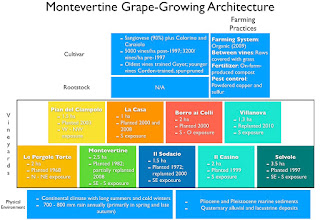With visits to Italian vineyards (or any outside the US, for that matter) out of the question, I have turned to reporting on wines where I have drunk multiple vintages but have not yet reported on the label in my blog. Using this approach, I researched and posted on three Montalcino wines (Soldera, Poggio di Sotto, and Cerbaiona) and discovered that they had each used Giulio Gambelli as their enological advisor. Mr. Gambelli started with these estates when they were in the fledgling stages so a significant portion of their success must be attributable to his efforts. Based on that perspective, I set out to find other Sangiovese-based estates with which he had been associated. I found such an estate in Montevertine (best known for its iconic Le Pergole Torte label and wine) and report on it in this post.
Montevertine grows grapes and produces wine approximately 3 km outside the Chianti Classico commune Radda in Chianti.
The location in question was in use since the 11th century but its life as Monvertine began with its purchase by Sergio Manetti (an iron and steel industrialist) in 1967 as the site for a holiday home. Manetti planted 2 ha of vines, and erected a small winemaking cellar, as part of the property refurbishment. His idea was to produce small quantities of wine that be could be given as gifts to customers, employees, and friends.
The first vintage produced was 1971 and it was so good that Manetti arranged to have some bottles sent to Vinitaly in Verona; they were well received. This initial success prompted Manetti to leave his existing career and instead become a full-time wine producer. In pursuit of that goal he built out a team that included the aforementioned Giulio Gambelli and with Bruno Bini as the cellarman. The estate's only label (at that time) was named Montevertine.
Over time, Sergio planted new vineyards and developed the guiding principles (simplicity, respect, detail-oriented, know-how) that guide the estate to this day.
Sergio's quality focus, and his vision for his wine, led to him leaving the Chianti Classico Consortium in 1981. Today a Chianti Classico DOCG wine is comprised of a minimum of 80% Sangiovese and maximum 20% of other red grapes to include Colorino, Canaiolo, Cabernet Sauvignon, and Merlot. But that was not always the case. The original Chianti DOC specification (1967) required, in addition to the Sangiovese, between 10 and 30% of white grapes for, according to Jancis Robinson, "the entirely expedient reason that it provided a convenient use for the substantial proportion of pale-skinned grapes then planted in the zone ... The great majority of white wine grapes that used to go into Chianti, blanching its colour and diluting its flavour, were the most basic sort of Trebbiano whose wine is generally near flavourless ... " Sergio refused to include Trebbiano in the Montevertine blend and, in the ensuing dispute, left the consortium and the Chianti Classico denomination.
Sergio, unfortunately, died in 2000 and management of the estate passed to his son Martino. When Gambelli died, his protégée Paolo Salvi joined the Manetti team as enologist.
The current estate is 18 ha in size and is planted to Sangiovese (90%), Colorino, and Canaiolo. The Montevertine grape-growing architecture is illustrated graphically in the chart below.
As shown below, the estate produces three wines, all blends of the estate's cultivars.
The Le Pergole Torte was first released in 1977 and was the first 100% Sangiovese wine produced in the Radda in Chianti area. It is made from the best grapes drawn from the vineyards planted between1968 and 1999.
Tasting Selected Vintages of Le Pergole Torte
I have tasted a number of the Le Pergole Torte vintages.
The 2006 Le Pergole Torte showed spice, violets, faded roses, and a slight balsamic on the nose. Rose water, sour cherry, black pepper, and salinity on the palate. Elegance with an ethereal finish.
The 2008 Le Pergole Torte showed berries, earth, herbs, and leather on the palate. Sour cherry, spices, and velvety tannins on the palate. Elevated acid levels. Lengthy finish
2009 was a hot vintage and the wine reflected as such. Ripe red and black fruit on nose and palate along with mint and spices. Leather and tobacco on the nose. Lengthy finish.
The 2012 yields were down due to uneven ripening. Dark fruit, licorice, and spices on the nose with a sour cherry character and velvety tannins experienced on the palate. Lengthy finish.
The 2013 Le Pergole Torte was tasted on a rooftop restaurant overlooking the square in front of the Duomo in Milan. Elegant, and not because of the setting. Intense nose of dark cherries, plum and licorice carries through to the palate. Lengthy finish. This wine will be around for a while.




No comments:
Post a Comment